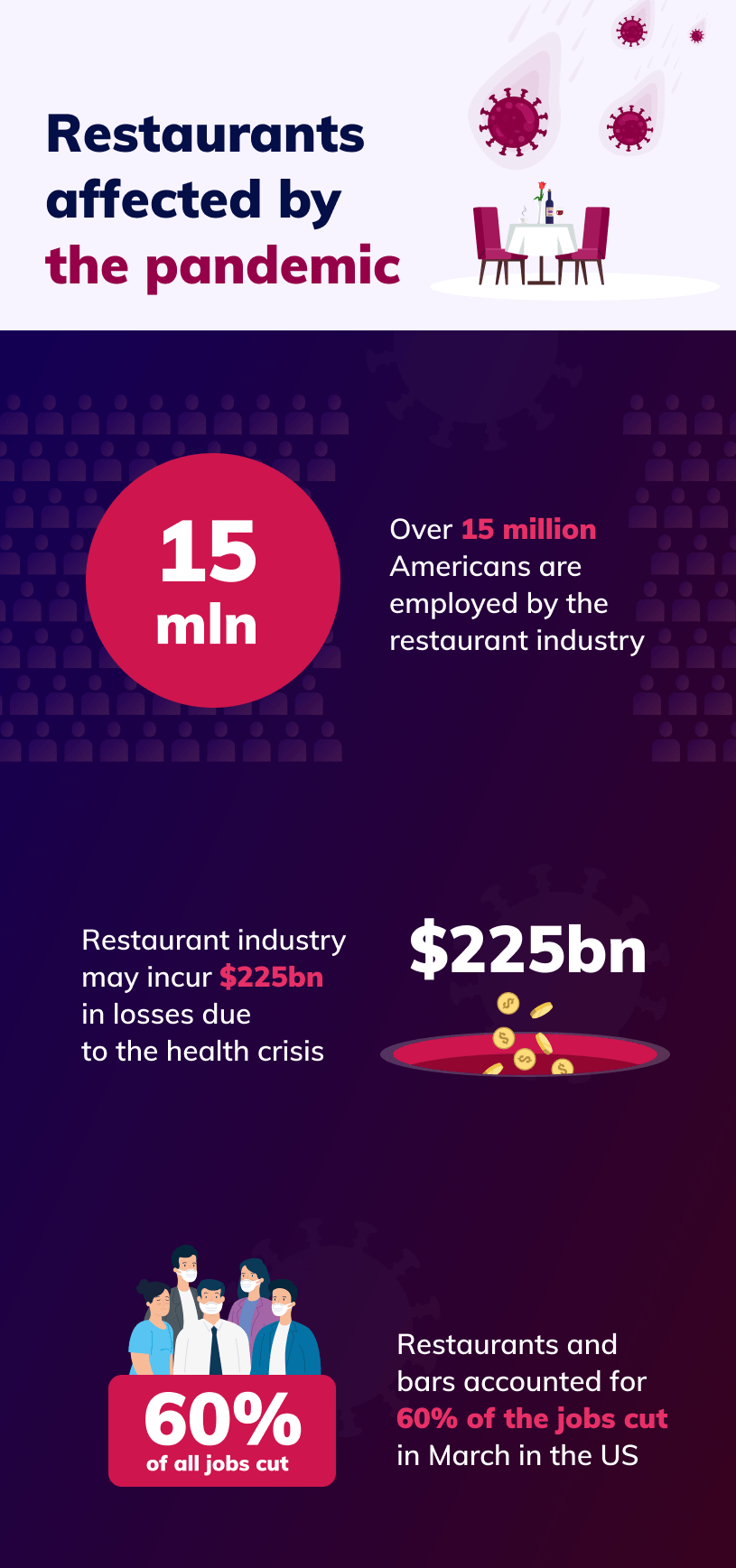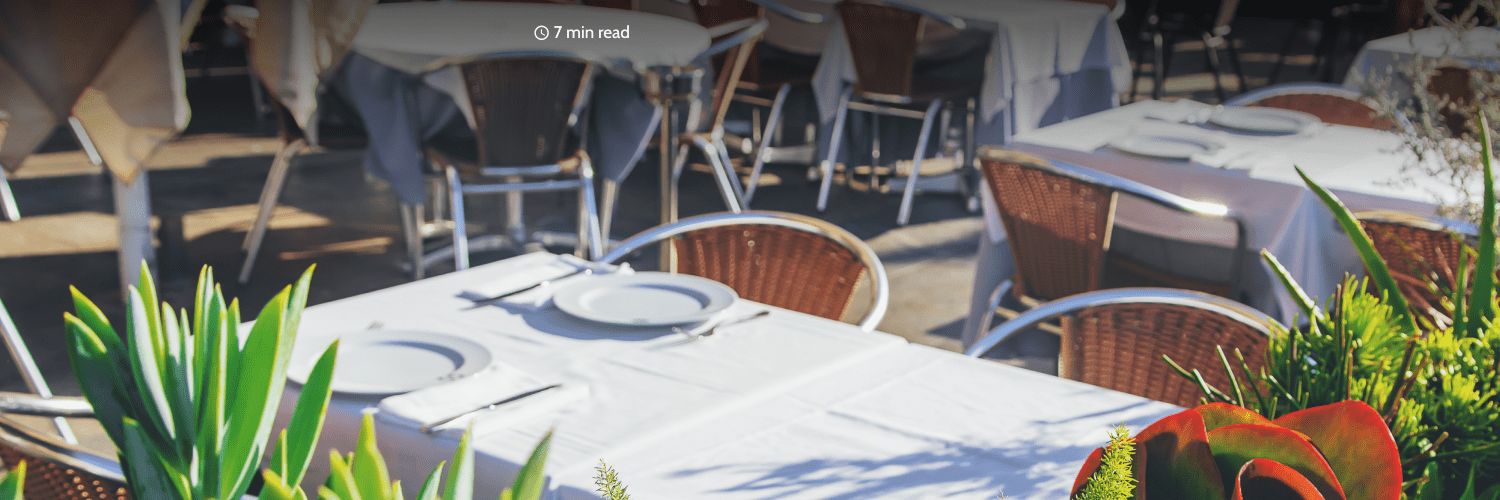The spread of COVID-19 made phrases like ‘social distancing’ a part of our vocabulary. But what does it mean for those who work in industries directly dependent on socializing, such as the restaurant industry? Here we want to talk about the ways in which restaurant businesses might continue their operations in a way that would be safe for their employees and beneficial for their communities.

Over 15 million Americans are employed by the restaurant industry, which is one of the most hardly hit across the country. While no sector was immune, restaurants and bars accounted for 60%, or 419,000, of the jobs cut in March, according to an official report from the bureau of labor statistics. In comparison, another hardly-hit category – hotels, has reported a loss of 29,000 jobs in the same month. Many of those employees were able to sign up for unemployment benefits, and hopefully, a number of small restaurants were able to receive some help from PPP and EIDL, programs to support American businesses and their workforce that have been exhausted and are now awaiting renewal and further funding.
Despite very negative outlooks, we’ve begun to see first signs of new normalcy – ways, in which restaurant owners are making the best out of their situation. In this article, we wanted to highlight those practices, which help restaurants and their employees while benefiting their communities.
Many commentators and restaurant owners seem to be talking about the same thing – things will change. The restaurant industry will not go back to normal, and there are many reasons why, all of which we won’t be able to cover in this piece but can mention some of them:
- Health measures – the current crisis made us more aware of the need to abide by strict health norms, and it will inevitably lead to stricter checks on how kitchens operate, more acceptance for staying home when coughing or sneezing (true for both the staff and the customers), less tables and more space to keep a healthier distance.
- Less cash – countries across the world are already seeing that cash has even more cons than previously predicted. For one thing, it’s unhygienic. It’s also harder to manage, account for, store, and deposit.
- Changed clientele – whether it’s a pandemic or not, people will have to eat. Another question is how much they will be physically able to spend when there is a global recession expected. Higher-end restaurants will have to ask themselves whom they will serve. Gastronomy tourism might see a spike once the lockdowns and travel restrictions are lifted, but in the long run, most restaurants will see that they have to be able to rely on regular customers.
We have tried to see if there are things that restaurants can do right now to keep operating on some level and here are 3 main directions that we have found to be the most promising.
- Going local
The newest examples of restaurants being able to keep a part of their normal income all share one thing – they serve the local population. It’s clear why: long-distance travel and deliveries are almost impossible right now, but there are people right now, in your neighborhood, who need to eat. Safe deliveries (paid for online, left by the door, by a courier wearing protective gear), pick-ups with as little human contact as possible (ideally also left on the counter and not handed in by a member of staff, prepared by kitchen staff maintaining social distancing and undergoing daily health and temperature checks) when possible can save your business to some extent, and even though you most likely won’t be able to come close to your normal earnings, it will help you use pre-ordered food supplies without them going to waste, keep more people on payroll and serve your local community.
- Adopting a digital model
It is very likely that whichever action plan you choose right now, you will see that you are absolutely needing a good online presence to let your potential customers know that you are available and to receive payments from them online, which is the safest way to get paid right now for a number of reasons we’ve cited in previous sections.
In case you already have a good website, it’s a good idea to have a dedicated COVID-19 section, updated regularly with a date of update cited, to let your customers know what you can do for them at this time in a clear and simple language.
If you don’t have a website yet, don’t worry. Instagram is a great option that businesses can use right now without overwhelming themselves with the task of creating a perfect website. Get hold of the best camera device you have on hand, try to be creative with your photography and use apps like Synder to create a payment link for your Instagram bio. According to a recent Facebook survey, 83% of Instagram users discover new products and services on the platform, and 54% of people make a purchase after seeing a product or service on Instagram.
Here, even if you are unable to continue physical operations because of strict lockdown regulations, you can continue engaging with your clients and offer them educational sessions, by giving a class on starting a business as an experienced business owner, asking (and paying) your chefs to host cooking master-classes for all these cooking newbies stuck at home without skills and willing to learn – just think about who works for you, what are their superpowers and start spreading the word. There are already many stories about people continuing to work by offering online classes, and Instagram live can be a great place to start.
Becoming more integrated into your community
This one is actually a natural summary of all that we’ve covered above. Both for now and for the long run businesses are expected to benefit from becoming more closely involved with their community.
Speaking of things that you can do right now, one example is focusing on offering food and drinks to essential workers. Bon Appetit magazine shared a great story of Sam Penix, a coffee shop owner in New York, who now delivers coffee to essential workers, paid for by fundraising efforts. Not only does he brew coffee for people who really need it right now, often working extra hours and with almost no time for a break. He also managed to buy supplies from other small businesses, helping them stay afloat, and was able to hire one more person to help him make coffee.
There are other larger examples of entire programs dedicated to buying food from local restaurants to deliver it to those in need, such as this one in New York, this one in London focusing on delivering food to NHS workers, and this one across the States.
This ingenious idea of connecting the two – restaurants perfectly equipped to feed people, with those who need meals the most, is a strategy that can be used on any scale, as you can see from an example of a one-person run project to large-scale programs that continue to grow. If you can think of needs in your community, that you are already intimately familiar with as a neighborhood business, you might be able to come up with an idea that can be shared via social media, and attract supporters, allowing them to support you in supporting others. Somehow, this example of a shared consciousness of our interdependence fits so well with the current times and can work well for restaurants, looking at their options in present.
We hope that you are able to stay safe and well during this time, as this is the priority right now. If you are able to continue your operations in some way, we hope that these insights give you an idea of what you can do to continue serving your community and, if possible, keep your employees on a payroll. Share how you are managing your business during this time in the comments below and stay well!





